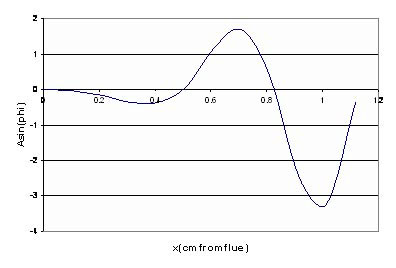Aeroacoustics
This is a highfalutin term used to encompass a range of phenomena that have in common the interaction of a stream or jet of air with a physical structure. Such jets occur in musical instruments, e.g., the transverse flute, the recorder, the flue organ pipe, and in other, very different, settings where they appear, e.g., in combustion systems, in rocket propulsion, and in astrophysical settings. In the musical context, the jet of air has been compared in its function to that of a reed. The jet oscillates like a reed at audio frequencies and drives a resonator. In the case of a true reed instrument we might be discussing a clarinet. When discussing the "air reed" we could be talking about a flue organ pipe, say, and the body of the pipe is the resonator. Perhaps the simplest system where we can study the air reed is the edge tone generator. A jet of air falls upon an edge arranged something like:
The flue that shapes the jet is formed by squashing one end of a tube with initially round cross-section until its cross-section at the flue end looks almost rectangular. Air flow through the tube is controlled by metering valves. The sound field can be produced by a number of techniques:
Some recent student theses on aeroacoustics:
A study that was related to these but concerned with explosive or shock waves rather than oscillatory waves:
In all of these, we use the deflection of light by the acoustic disturbance as a diagnostic tool. For information on this technique see P.J. Millet, Rosette Khosropour, "Demonstrations with a Position-Sensitive Detector," The Physics Teacher, 38, 418-422 (2000). (Copyright 2000 American Association of Physics Teachers. This article may be downloaded for personal use only. Any other use requires prior permissions of the author and the American Association of Physics Teachers) Some physics to be learned by student researchers engaged in the studies concerned with tone production: fundamentals of fluid flow, jet instability, background on applications of oscillating jets in musical acoustics and other settings, interaction between fluid flow fields, sound, and light, the use of a two-phase lock-in amplifier.
|

